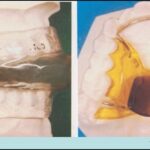
Obstructive sleep apnoea is characterised by obstructions to the upper airways during sleep. This results in snoring, temporary cessation of breathing, sleep fragmentation and daytime sleepiness. Is affects around 6% of women and 12.5% of men over the age of 40. The gold standard for diagnosis of obstructive sleep apnoea (OSA) is polysomnography (PSG) which allows assessment of the apnoea/hypopnea index (AHI), an expression of OSA severity. continuous positive air ways pressure (CPAP) is the gold standard treatment for OSA although evidence indicated that oral appliances, most commonly mandibular advancement devices (MADs) can reduce AHI. MADs can be prefabricated or customised, and they can be divided into mono-bloc (MB) and duo- bloc (DB) appliances.
The aim of this review was to investigate the effectiveness of different customised MAD designs in reducing AHI and improving oxygen saturation in OSA patients.
Methods
The review was registered on PROSPERO and searches undertaken in the Medline, Cochrane Database of Systematic Reviews, Google Scholar Beta, Scopus, LILACS and Web of Science. Databases. Only randomised controlled trials (RCTs) conducted in adults involving customised MADs for the treatment of OSA were considered. Two reviewers independently selected the studies with conflicts being resolved by discussion. Risk of bias was assessed using the Cochrane RoB2 tool and overall quality assessed using the Grading of Recommendations Assessment, Development and Evaluation (GRADE) approach.
Results
- 50 RCTs were included
- 11 studies were considered to have a low risk of bias,8 a high risk and 31 some concerns.
- 3 of 6 studies comparing MB and DB designs concluded that MB were more efficient in reducing AHI and 3 found equal effectiveness.
- 8 of 13 studies showed CPAP to be more effective than MAD with 4 showing no difference.
- 11 studies compared MAD with placebo with only 1 study concluding placebo was equally effective as MAD.
- Meta-analysis (41 studies) showed a higher success rate with mono-bloc 0.821 (0.722-0.887) than duo-bloc MADs 0.547 (0.443-0.637), [very low-quality evidence].
- Meta-analysis (21 studies) showed better effectiveness for mono-bloc 10.048 (7.733-12.363) compared with duo-bloc in improving the minimum oxygen saturation and 3.357 (2.290-4.423), [very low-quality evidence].
Conclusions
The authors concluded: –
There is a very low-quality body of evidence that mono-bloc MADs are more effective in reducing AHI and improving minimum oxygen saturation compared with duo-block MADs. Since the compliance plays a crucial role in the success of the therapy, it is important to produce further studies directly investigating different designs addressing both efficacy and compliance.
Comments
While a large number of databases were searched the inclusion of only English language papers means that some relevant studied might have been excluded. Only 11 of the included studies were considered to be at low risk of bias and as the authors highlight most of the studies did not directly compare the different MAD designs in reducing AHI. It is also worth noting that 22 out of the 50 included studies (44%) had fewer that 30 participants. The authors assessed the overall certainty of the evidence using GRADE as very low. Consequently, high quality well conducted and reported studies of appropriate size are needed to clarify the effectiveness of MADs. Studies should also include the assessment of adverse effects as there may be time-related dental and skeletal side effects (Dental Elf- 19th Dec 2018).
Links
Primary Paper
Bartolucci ML, Bortolotti F, Corazza G, Incerti Parenti S, Paganelli C, Alessandri Bonetti G. Effectiveness of different mandibular advancement device designs in obstructive sleep apnoea therapy: A systematic review of randomised controlled trials with meta-analysis. J Oral Rehabil. 2020 Aug 17. doi: 10.1111/joor.13077. Epub ahead of print. PMID: 32805753.
Other references
Dental Elf- 19th Dec 2018
Dental Elf – Sleep Apnoea Blogs
Photo Credits
By PruebasBMA – Own work, CC BY-SA 3.0
